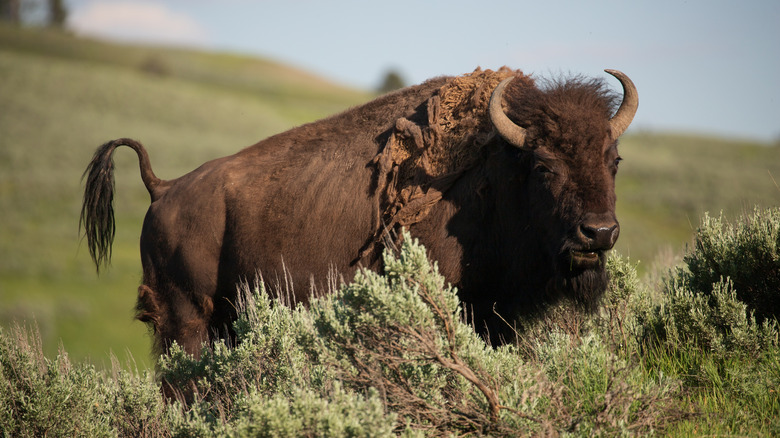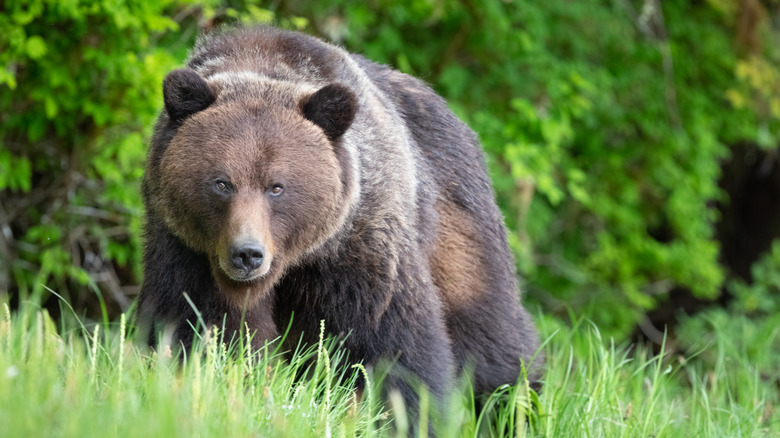Warning Signs A Cool National Park Wildlife Sighting Is About To Turn Into A Dangerous Encounter
America's parks are natural treasures enjoyed by millions each year. From iconic Yellowstone, the country's first national park, to the Great Smoky Mountains National Park, the most visited, visitors immerse themselves in the natural world. A wilderness visit is not without risk, however. Yosemite is one of the most popular but also one of the most dangerous national parks, particularly for clueless tourists and adrenaline junkies behaving recklessly and risking their lives.
Some of those dangers include wildlife encounters. A magical moment can quickly turn catastrophic for visitors, especially if they can't read the warning signals a wild animal is sending. Elk and bison have been known to charge oblivious visitors. Bears attack when threatened. And it's not always the predators and big animals that cause injuries. Recently, even rodents are getting aggressive in Yosemite.
Encroaching on a wild animal's space is one of the most common mistakes first-timers make while visiting a national park. So, what are the warning signs that your up-close encounter with wildlife is about to take a dangerous turn?
Beware the pointed bison tail
The Tallgrass Prairie National Preserve in the Flint Hills of Kansas is the largest expanse of wild prairie still intact in the world, the natural home of the majestic American bison. The park's number one piece of advice for dealing with this animal: "Keep 125 yards distance," the park warned in a Facebook post, "Do not attempt close contact or petting the bison. Despite their size, bison are strong and can run up to 35 mph. If necessary, navigate off-trail around the bison. If your presence causes a bison to move, you are too close."
If you do find yourself close to a bison, make sure you keep them in your sights and keep an eye on their tail. "The bison's tail position is like a weathervane," the park's Facebook post explains, "A tail hanging loosely indicates the animal is relaxed. If partially raised, the bison is alert. The bison is excited with a horizontal tail. A tail raised upward is a warning; the bison is in a combative posture and may be ready to charge."
Don't be fooled into thinking a fence will protect you. Bison are the largest mammals in North America, weighing as much as 2,000 pounds and standing as high as 6 feet. They are also extremely agile and surprisingly fast, moving up to 35 miles an hour. A flimsy wooden fence won't stop a charging bison. Wild bison are most likely to be seen in Yellowstone or the surrounding region of the upper midwestern plains.
Steer clear of bellowing elk
Hiking the Tomales Point Trail that runs along the coast of Northern California, visitors are almost guaranteed to see elk. But that's just one location where this species is common; in fact, there are three species of elk found in North America, most of which are distributed along the Pacific Coast and Rocky Mountains. All the more reason for hikers to know beforehand what the danger signs are. First and foremost, the National Park Service advises keeping at least 100 feet away from these wild animals. That's about the length of a basketball court. A good rule of thumb: If an elk stops grazing to stare at you, you're too close.
Late summer to early winter is elk mating season, also known as rutting season, when bull elk compete for mates. These bulls put on an aggressive display to intimidate other bulls and are especially agitated. Rutting behavior to watch for includes bellowing and scraping with their antlers. The National Park Service advises keeping an eye out for these warning signs: "When alarmed, elk raise their heads high, open their eyes wide, move stiffly, and rotate their ears to listen."
The National Park Service also warns that visitors should be especially cautious during mating and calving seasons. Elk calving season happens in late spring and early summer, when cow elk are minding their young and vulnerable calves. They can get particularly aggressive in defending the area where calves are bedding. So, be careful when walking around blind spots like corners or even cars. You never know where a mama elk has chosen a warm spot for her kids.
Convincing a cougar that you are not prey
Washington's Olympic National Park is best known for its salmon, jumping up the tumbling waterfalls during spawning season. The area also has a healthy population of cougars, also known as pumas or mountain lions. These large cats can weigh up to 150 pounds and are stealthy hunters. These are wild animals that prefer not to be seen. So, if you do encounter one, be on alert and learn how to remove yourself as safely as possible.
The most important thing to know when dealing with this apex predator is to signal that you are not prey. Do not run. "Running may stimulate a mountain lion's instinct to chase, " advises the National Park Service, "Instead, stand and face the animal. Make eye contact. If you have small children with you, pick them up if possible so that they don't panic and run. Although it may be awkward, pick them up without bending over or turning away from the mountain lion."
If the cougar crouches down, with teeth bared, hissing and switching its tail, that's a signal it may be about to pounce. Do what you can to appear larger by raising your arms or opening your jacket. Speak loudly and firmly, in a calm voice. If attacked, fight back. The more difficult and troublesome you are as a target, the less likely the cougar will want to trouble with you.
Woofing and other bear warning signs
Alaska's underrated Katmai National Park is a top brown bear-viewing destination, with more than 2,000 bears living in the park, including grizzlies. But there are three bear species found in North America, the most widespread of which is the black bear, which lives in at least 37 states. The National Park Service advises traveling in groups and chatting with each other to be "noisier and smellier". Hearing human voices gives the bear plenty of warning to stay away.
If you do encounter a bear, the Park Service advises you to remain calm and assess the bear's behavior. Try not to surprise the bear. If it doesn't register your presence, back away while keeping alert for any changes in behavior. "Vocalizations like woofing, huffing, and jaw popping are almost always indications of stress," writes the National Park Service. "The position of a bear's ears also communicates information. Ears that are pointed forward usually indicate a sense of curiosity or dominance. Ears that are flattened back on a bear's head is indicative of stress and/or defensiveness."
Do not run away or shout at the bear. This may trigger it to chase after you. Bears can run up to 30 miles an hour, faster than any human. Bears may also charge defensively in a bluff charge, rushing towards the target, then stopping short as a kind of warning. In these cases, the National Park Service says, the key is to stand your ground to appear non-threatening. When the bear stops, you can start backing away slowly. Bear spray can also be released to dissuade an approaching bear. The best way to avoid a dangerous encounter, however, is to keep at least 50 yards away from any bear, about half the distance of a football field.




